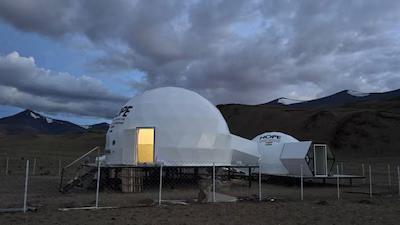
ISRO Sets Up Station in Ladakh to Simulate Life on Moon & Mars
In a milestone achievement for Indian space exploration, the Indian Space Research Organisation (ISRO) has set up the Himalayan Outpost for Planetary Exploration (HOPE) in Ladakh’s Tso Kar Valley. This state-of-the-art facility is designed to simulate the harsh conditions of the Moon and Mars, allowing scientists to test and refine life-support systems for future lunar and Martian missions.
Located at an altitude of 15,000 feet, the Tso Kar Valley was chosen for its unique combination of extreme environmental conditions, which are eerily reminiscent of the Martian landscape. The valley is characterized by high UV radiation, low atmospheric pressure, extreme cold, and saline permafrost – all of which pose significant challenges for human survival.
The HOPE station, which was established in collaboration with the Defence Research and Development Organisation (DRDO), will play a crucial role in the development of India’s lunar and Martian exploration programs. For the next 10 days, two crew members will undertake various tests at the facility to evaluate the performance of life-support systems, including air, water, and food supplies.
“We are excited to kick-start this simulation mission, which will help us validate our technologies and prepare for the challenges of Martian and lunar missions,” said an ISRO official, speaking to News18.
The HOPE station is equipped with advanced facilities, including a habitat module, life support systems, and communication equipment. The crew members will conduct a range of experiments, including testing the performance of air and water recycling systems, as well as evaluating the effects of radiation on living organisms.
The Tso Kar Valley, located in the Changthang region of Ladakh, is an ideal location for this simulation mission due to its extreme environment, which is similar to that of Mars. The valley’s high altitude and low atmospheric pressure make it an excellent analogue for the Martian surface, where the atmospheric pressure is about one-third of Earth’s.
ISRO’s HOPE station is a significant step forward in the country’s space exploration program, which has seen several major milestones in recent years. The organization has successfully launched a range of satellites, including the Chandrayaan-1 mission, which was India’s first lunar mission, and the Mangalyaan mission, which put India on the map as a major player in interplanetary exploration.
The HOPE station is also a testament to ISRO’s commitment to innovation and collaboration. The organization has worked closely with the DRDO and other stakeholders to establish this unique facility, which will play a critical role in the development of India’s space program.
As India continues to push the boundaries of space exploration, the HOPE station will serve as a vital testing ground for life-support systems and other technologies. The success of this simulation mission will pave the way for future lunar and Martian missions, and cement India’s position as a major player in the global space community.






